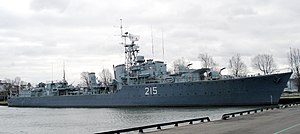 HMCS Haida docked in Hamilton, Ontario, as a museum ship
| |
| History | |
|---|---|
| Name | Haida |
| Namesake | Haida |
| Ordered | 5 April 1940 |
| Builder | Vickers-Armstrongs, Ltd., Newcastle-upon-Tyne |
| Yard number | 41 |
| Laid down | 29 September 1941 |
| Launched | 25 August 1942 |
| Commissioned | 30 August 1943 |
| Decommissioned | 20 March 1946 |
| Recommissioned | 15 March 1952 |
| Decommissioned | 11 October 1963 |
| Out of service | 22 February 1964 |
| Identification |
|
| Honours and awards |
|
| Status | Museum ship |
| General characteristics | |
| Class and type | Tribal-class destroyer |
| Displacement |
|
| Length | 377 ft (114.9 m) |
| Beam | 37 ft 6 in (11.4 m) |
| Draught | 13 ft (4.0 m) |
| Propulsion |
|
| Speed | 36.5 knots (67.6 km/h; 42.0 mph) (maximum), 32 knots (59 km/h; 37 mph) (service) |
| Complement | 259 (14 officers, 245 ratings) |
| Sensors and processing systems |
|
| Armament |
|
| Official name | HMCS Haida National Historic Site of Canada |
| Designated | 1984 |
HMCS Haida is a Tribal-class destroyer that served in the Royal Canadian Navy (RCN) from 1943 to 1963, participating in World War II and the Korean War.[2] She was named after the Haida people.
The only surviving Tribal-class destroyer out of 27 vessels constructed for the RCN, the Royal Navy, and the Royal Australian Navy between 1937 and 1945, Haida sank more enemy surface tonnage than any other Canadian warship and as such is commonly referred to as the "Fightingest Ship in the Royal Canadian Navy".[3][4]
Designated a national historic site of Canada in 1984, she now serves as a museum ship berthed next to HMCS Star, an active Royal Canadian Naval Reserve Division, in Hamilton, Ontario.[5][6] In 2018, Haida was designated the ceremonial flagship of the RCN.
- ^ Arbuckle, p. 46
- ^ Brewster, Murray (26 August 2023). "HMCS Haida — the 'fightingest' ship in the Royal Canadian Navy — turns 80". CBC News. Retrieved 27 August 2023 – via MSN.com.
- ^ "Canada to Honour "the Fightingest Ship in the Royal Canadian Navy" (Press release). Parks Canada. Archived from the original on 1 April 2017. Retrieved 1 April 2017.
- ^ "RCN flagship: HMCS Haida, Canada's "fightingest ship"". Government of Canada. 23 October 2014. Archived from the original on 16 September 2022. Retrieved 16 September 2022.
- ^ "HMCS Haida". Directory of Designations of National Historic Significance of Canada. [dead link]
- ^ HMCS Haida National Historic Site of Canada. Canadian Register of Historic Places. Retrieved 1 July 2015.